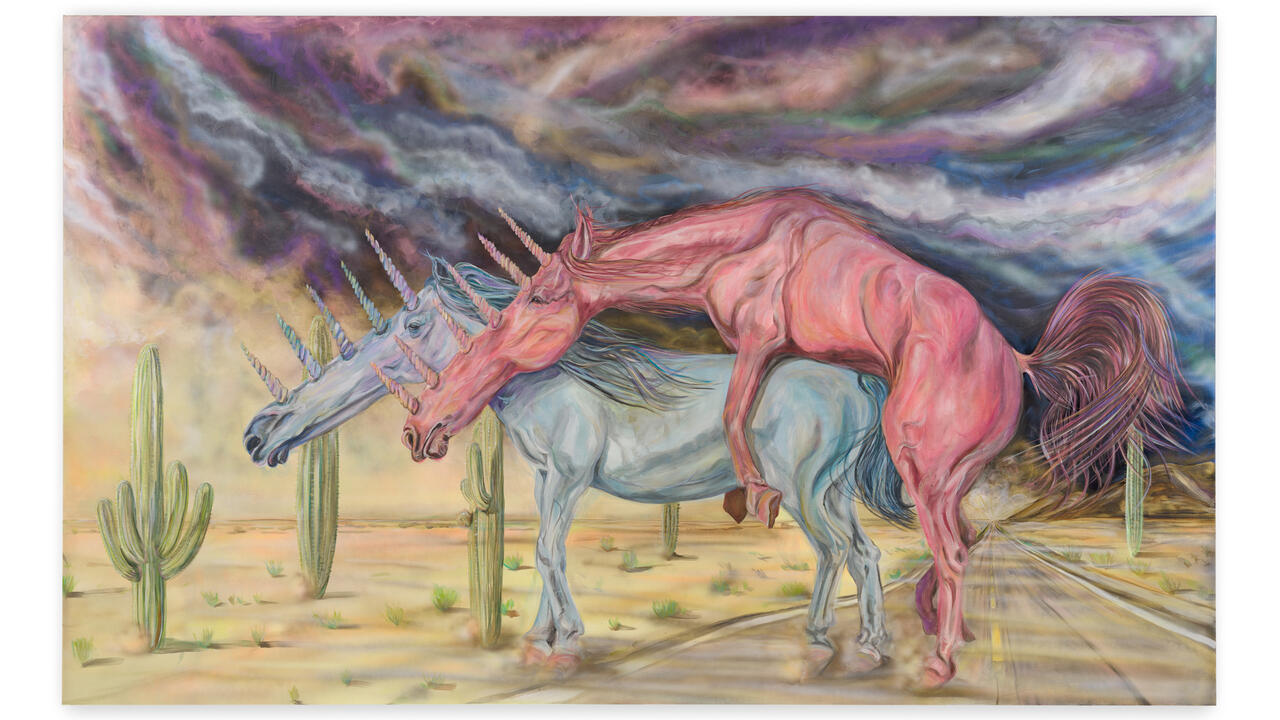Victor Houteff
Cabinet, New York, USA
Cabinet, New York, USA

‘Victor Houteff: At the Eleventh Hour’ was as much a historical record as it was an art exhibition. Its most indelible referent – the one that caught the attention of much of the world – was the 51-day Waco Siege in 1993, in which 76 Branch Davidians, led by David Koresh, died along with four FBI agents.
Houteff, who emigrated to the United States from Bulgaria in 1907, joined the Seventh-day Adventist Church after attending a meeting in 1918. By the late 1920s, he was guiding Adventist teachings toward a stricter fundamentalism, and in 1935 he legally split from the church and formed the Davidian Seventh-day Adventists, taking with him a handful of disciples. Following his death, and his wife’s disillusioned departure in 1972, the church, renamed the Branch Davidians, went through various heads until 1987, when it passed to Koresh.
The eight drawings that lined the small exhibition space at the Cabinet magazine office in Brooklyn date from the mid-1930s to the mid-’40s, during which time Houteff was establishing his organization, relocating it from the Los Angeles area to a Texas property he called Mt. Carmel, just east of Waco. Complex pen-and-ink illustrations of Bible scenes, and explanatory texts, detail Houteff’s beliefs and form a timeline leading to the apocalypse. The pieces were drawn from the collection of artist Jim Shaw, who found them at a Pasadena flea market. Since 1990, Shaw has been collecting and exhibiting art from thrift stores and flea markets throughout the United States; most are high-art misconceptions by anonymous amateurs that stutter through the fringes of pop culture. The Houteff pieces stand out not only because they have an author, but because of the mastery their author exercises over their execution and content – a mastery that attests to the drawings’ real-world history. The result is an interrogation both of Shaw’s practice and of the contemporary art world’s general cynicism toward religion. Shaw’s ongoing series of work with his invented religion ‘Oism’ – allegedly ‘founded’ in the mid-19th century and dedicated to a supreme female deity symbolized by the letter ‘O’ – echoes the cynicism by parodying belief systems through the histrionic language of the religious epic.
Houteff’s drawings reflect 19th- or early-20th-century children’s book illustrations, with luminous, jewel-hued phantasmagorias of dragons, hellfire and heavenly salvation. In The Church and the Dragon (1932), a crowned woman stands between the abyss of outer space and a six-headed ruby-red dragon, with a banner identifying the heads (The Church, Civil Government, Complete Apostasy, Civil Authority, Satan). A timeline supplements the figures and two headlines proclaim ‘The Period Without the Bible’ and ‘The Period With the Bible’. Similarly, The Harvest Period and The Close of Probation (c.1938) depicts a cheery parade of men and women riding mythological creatures into blazing fires. The illustrations are simplified for maximum legibility and compressed into one-page narratives that sunder the linearity of time as they face the viewer with millennia worth of astounding history.
Had the story of the Davidians unfolded differently, the drawings might have been curiosities at a folk art museum. Instead, history tasks the viewer with the challenge of confronting the content. The domestication of something like Henry Darger’s ‘Vivian Girls’ chronicle, or, in a different context, the painting by serial killer John Wayne Gacy, Jr. (included in Mike Kelley’s installation ‘Pay for Your Pleasure’ (1988) at the University of Chicago’s Renaissance Society), entails a framing of the art as artefact – an amputation of the artist’s belief system from the image. ‘Pay for Your Pleasure’ was, if anything, a shrine to disbelief, Gacy’s painting a metonym for its maker held in safe abeyance from its real history. But disbelief requires its own kind of faith. For a secular crowd, Houteff’s self-assurance is almost funny; his apocalypse is propped up by such a vicious rhetoric of fire, brimstone and ‘death to the sinners’ that the label ‘outsider’ art seems inadequate, but makes most contemporary art seem utterly dull. It’s not hard to find excitement in the Book of Revelations, and Houteff clearly knew how to visualize it for an audience.
What’s most unsettling about the art is the scope of its influence. The history of the Davidians is inseparable from the illustrations. By the time Houteff disseminated them, he headed an organization with several hundred members. He died before his prophesized date of apocalypse. His wife predicted a later date; when nothing materialized, she left the church. Koresh reportedly predicted that the FBI would invade his Mt. Carmel headquarters – probably a safe bet for a compound that was stockpiling sub-machine guns – and, after his death, his remaining followers predicted his resurrection. Some may still be waiting. The novelty of the images, installed like comic-book frames in an office in Brooklyn, belies their horrendous success.






















